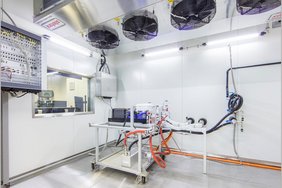NEW ANODE OPTIMIZATION TOOL TO REDUCE THE H2 CONSUMPTION OF FUEL CELLS
In the COMET project HyTechonomy, experts from science and industry are working together to develop technologies for H2 generation, storage, distribution, and application via fuel cell in the mobility, industry, and energy sectors. Furthermore, optimization potentials through sector coupling of energy, industry and mobility as well as the ideal combination of key technologies are identified.
The sub-project Hyfficient aims to optimize stationary fuel cell systems. To guarantee reliable operation and avoid damages, fuel cells are operated over-stoichiometrically. This leads to the fact that the unused hydrogen has to be recycled to avoid efficiency losses and to avoid increased hydrogen consumption. In conventional fuel cell systems, this is accomplished by a hydrogen recirculation blower. The power consumption for the blower has a negative effect on the overall efficiency and is, besides others, one of the largest consumers of the auxiliary power. If the blower is replaced by a unit consisting of a hydrogen injector with an ejector operating on the jet pump principle, the electrical consumption for recirculation can be reduced by approx. 85 %. Due to the high flow velocity of the hydrogen expanding in the ejector, a high momentum is generated and the recirculated hydrogen is sucked in by means of momentum exchange without having to use additional mechanical energy.
The challenge at designing the ejector is to optimize the recirculation rate and ensure it even in part-load operation. At the same time, a deep understanding of the thermo-dynamic and flow processes is required in order to avoid pressure pulsations as far as possible by taking appropriate measures.
Impact and effects
Within Hyfficient, a generic method using 1D and 3D CFD simulations was further developed to generate the optimal design of the ejector. The method is easily applicable for different fuel cell system sizes and operating strategies.
For the optimization of hydrogen consumption (anode side), the developed method was applied and an ejector for the specific fuel cell system of the project partner Fronius was designed and optimized. In the second year of the project, an ejector prototype will be built and tested based on the optimized design. With the measurement data the simulation models will be validated and further improved.
Project partner
- AIT, AUT
- AVL, AUT
- BEST Research, AUT
- Fronius, AUT Henn, AUT
- Henn, AUT
- Profactor, AUT
- Postbus, AUT
- TU Graz (CEET, IWT, ITNA), AUT
- Verbund, AUT


